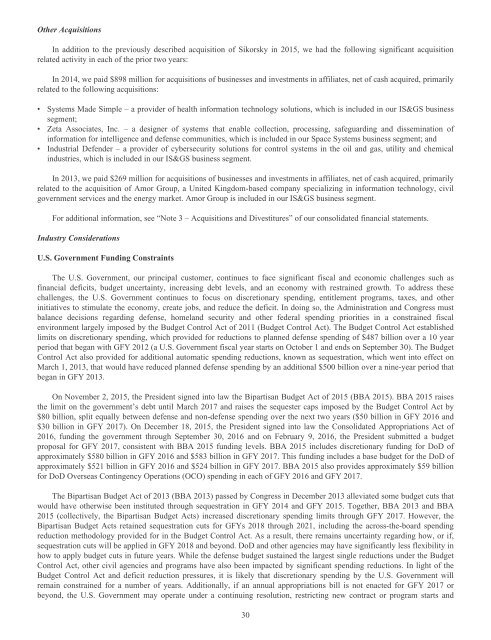LOCKHEED MARTIN CORPORATION
2015-Annual-Report
2015-Annual-Report
You also want an ePaper? Increase the reach of your titles
YUMPU automatically turns print PDFs into web optimized ePapers that Google loves.
Other Acquisitions<br />
In addition to the previously described acquisition of Sikorsky in 2015, we had the following significant acquisition<br />
related activity in each of the prior two years:<br />
In 2014, we paid $898 million for acquisitions of businesses and investments in affiliates, net of cash acquired, primarily<br />
related to the following acquisitions:<br />
• Systems Made Simple – a provider of health information technology solutions, which is included in our IS&GS business<br />
segment;<br />
• Zeta Associates, Inc. – a designer of systems that enable collection, processing, safeguarding and dissemination of<br />
information for intelligence and defense communities, which is included in our Space Systems business segment; and<br />
• Industrial Defender – a provider of cybersecurity solutions for control systems in the oil and gas, utility and chemical<br />
industries, which is included in our IS&GS business segment.<br />
In 2013, we paid $269 million for acquisitions of businesses and investments in affiliates, net of cash acquired, primarily<br />
related to the acquisition of Amor Group, a United Kingdom-based company specializing in information technology, civil<br />
government services and the energy market. Amor Group is included in our IS&GS business segment.<br />
For additional information, see “Note 3 – Acquisitions and Divestitures” of our consolidated financial statements.<br />
Industry Considerations<br />
U.S. Government Funding Constraints<br />
The U.S. Government, our principal customer, continues to face significant fiscal and economic challenges such as<br />
financial deficits, budget uncertainty, increasing debt levels, and an economy with restrained growth. To address these<br />
challenges, the U.S. Government continues to focus on discretionary spending, entitlement programs, taxes, and other<br />
initiatives to stimulate the economy, create jobs, and reduce the deficit. In doing so, the Administration and Congress must<br />
balance decisions regarding defense, homeland security and other federal spending priorities in a constrained fiscal<br />
environment largely imposed by the Budget Control Act of 2011 (Budget Control Act). The Budget Control Act established<br />
limits on discretionary spending, which provided for reductions to planned defense spending of $487 billion over a 10 year<br />
period that began with GFY 2012 (a U.S. Government fiscal year starts on October 1 and ends on September 30). The Budget<br />
Control Act also provided for additional automatic spending reductions, known as sequestration, which went into effect on<br />
March 1, 2013, that would have reduced planned defense spending by an additional $500 billion over a nine-year period that<br />
began in GFY 2013.<br />
On November 2, 2015, the President signed into law the Bipartisan Budget Act of 2015 (BBA 2015). BBA 2015 raises<br />
the limit on the government’s debt until March 2017 and raises the sequester caps imposed by the Budget Control Act by<br />
$80 billion, split equally between defense and non-defense spending over the next two years ($50 billion in GFY 2016 and<br />
$30 billion in GFY 2017). On December 18, 2015, the President signed into law the Consolidated Appropriations Act of<br />
2016, funding the government through September 30, 2016 and on February 9, 2016, the President submitted a budget<br />
proposal for GFY 2017, consistent with BBA 2015 funding levels. BBA 2015 includes discretionary funding for DoD of<br />
approximately $580 billion in GFY 2016 and $583 billion in GFY 2017. This funding includes a base budget for the DoD of<br />
approximately $521 billion in GFY 2016 and $524 billion in GFY 2017. BBA 2015 also provides approximately $59 billion<br />
for DoD Overseas Contingency Operations (OCO) spending in each of GFY 2016 and GFY 2017.<br />
The Bipartisan Budget Act of 2013 (BBA 2013) passed by Congress in December 2013 alleviated some budget cuts that<br />
would have otherwise been instituted through sequestration in GFY 2014 and GFY 2015. Together, BBA 2013 and BBA<br />
2015 (collectively, the Bipartisan Budget Acts) increased discretionary spending limits through GFY 2017. However, the<br />
Bipartisan Budget Acts retained sequestration cuts for GFYs 2018 through 2021, including the across-the-board spending<br />
reduction methodology provided for in the Budget Control Act. As a result, there remains uncertainty regarding how, or if,<br />
sequestration cuts will be applied in GFY 2018 and beyond. DoD and other agencies may have significantly less flexibility in<br />
how to apply budget cuts in future years. While the defense budget sustained the largest single reductions under the Budget<br />
Control Act, other civil agencies and programs have also been impacted by significant spending reductions. In light of the<br />
Budget Control Act and deficit reduction pressures, it is likely that discretionary spending by the U.S. Government will<br />
remain constrained for a number of years. Additionally, if an annual appropriations bill is not enacted for GFY 2017 or<br />
beyond, the U.S. Government may operate under a continuing resolution, restricting new contract or program starts and<br />
30


